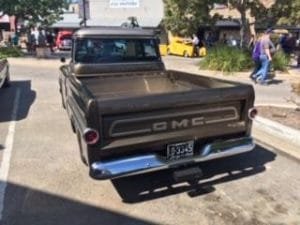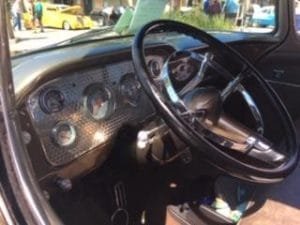Our featured vehicle is a fine looking 1958 GMC Fleetside Half Ton Pickup.
GMC as a truck brand was created out of a merger of the Reliance Motor Car Company and the Rapid Motor Vehicle Company within General Motors. GMC as a brand was officially introduced in 1912 at the New York International Auto Show with the first truck built in July of 1911. GMC is an abbreviation for General Motors Company.
During it’s early years General Motors marketed their GMC light duty truck toward commercial business while the Chevy truck was marketed to the non commercial general public.

GMC, a division of General Motors Corporation, produced some great styled light trucks during the late 1950’s.
Over the decades several light truck manufacturers began styling their trucks with certain passenger car features and with good results. The reception was positive because in many cases car buyers began using light trucks for both business and pleasure.
During the 1950’s,, passenger car design influenced trucks to an even greater degree, and this included better mechanical performance, enhanced safety features and more comfort for passengers. Capable work horses, the trucks’ hooded headlights, panoramic glass, and wood trim made GMCs good looking style great for weekend cruising.
While GMC and Chevrolet produced light trucks together, there were times when the GMC resembled it’s Chevy cousin. For the true GMC fan this was not a good thing but there were always plenty of features to distinguish a GMC from a Chevy light truck. In general you could say that GMC was better equipped and offered generally higher quality compared to the standard Chevy truck. Another difference was that GMC and Chevy light trucks often offered different engines.
1958 was the first year for the GMC Fleetside. The Fleetside had the bed stretched over the rear wheels with flat side panels.
The Fleetside soon became the standard body style for trucks. Traditional stepside trucks remained with the bed located inside the wheels with protruding rear fenders. This makes the cargo bed a rectangle without wheel wells taking up cargo space.
The stepside style was continued by most automakers up until the early 2000’s but has now been discontinued.
1958 GMC Fleetside Pickup Specifications
The ‘1955-’59 GMCs, which were called the Blue Chip series, were available with a 6 cylinder in addition to the Pontiac sourced V-8. The six was actually a GMC manufactured engine, rather than a Chevrolet or Pontiac engine.. 1958 was the first real GMC V-8.
As a side note, 1955 saw the introduction of an optional V-8 for both Chevy and GMC trucks. Since GMC did not have their own V-8 they used the Pontiac engines in light duty trucks. As mentioned above this changed in 1958.
During the Task Force Series years, the base transmission for the GMC Half Ton was a three speed manual. Options included overdrive, a heavy duty three speed manual, a four speed manual and a Hydra-Matic four speed automatic.
 Brakes were four wheel hydraulic drums.
Brakes were four wheel hydraulic drums.
Total GMC production for 1958 was 55,950 vehicles. Out of that number about 18,600 were built in Canada.
Additional related Auto Museum Online articles are found on the links below..
1958 Chevy Apache 3200 Half Ton
Reference material for this article included..the GM and GMC archive collection. For a good deal of additional GMC Truck information along with forums check out www.gmctruckclub.com. GMC: The First 100 Years by John Gunnell..
1957 GMC Collector Popularity
 Both GMC and Chevrolet light trucks from the latter 1950’s are very popular collector vehicles. The GM Task Force Series introduced some great styling changes.
Both GMC and Chevrolet light trucks from the latter 1950’s are very popular collector vehicles. The GM Task Force Series introduced some great styling changes.
Highest prices as is typical are generally for fully restored, excellent overall condition, and highly original matching part models.
Recently restored GMC Half Tons from the Task Force years should be found in the $39,000-$60,000 area.
(Article and photos copyright Auto Museum Online)

